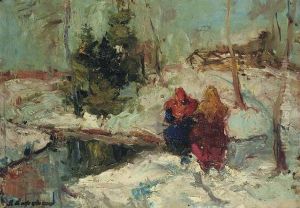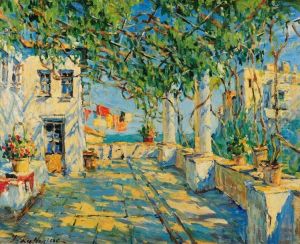Aleksandrovich Lapshin Georgii Paintings
Georgii Aleksandrovich Lapshin was a Russian and Soviet painter, graphic artist, and art teacher, recognized for his contributions to the development of Soviet art, particularly in the realm of Socialist Realism. Born on March 12, 1885, in the village of Malaya Vishera, Novgorod Governorate, Russian Empire, Lapshin showed an early interest in art, leading him to pursue formal education in the field.
In 1904, he moved to St. Petersburg, where he attended the Drawing School of the Society for the Encouragement of the Arts. Afterward, he continued his studies at the Imperial Academy of Arts under the guidance of prominent artists such as Ilya Repin and Dmitry Kardovsky. His academic training provided him with a solid foundation in classical art techniques, which he later adapted to fit the changing political and social landscape of his time.
Lapshin's early work was influenced by the realistic and impressionistic styles prevalent in the early 20th century. However, after the Russian Revolution of 1917, his focus shifted towards subjects that aligned with the Soviet state's goals. He became an active participant in the artistic life of the newly formed Soviet Union, joining the Association of Artists of Revolutionary Russia (AKhRR) in 1924. This group aimed to depict the lives of ordinary people and the transformation of society under socialism.
Throughout the 1920s and 1930s, Lapshin's work increasingly reflected the principles of Socialist Realism, the officially sanctioned art style of the Soviet Union. His paintings often portrayed workers, collective farmers, and scenes of industrial and agricultural development, idealizing the Soviet working class and their contributions to the construction of a communist society.
During his career, Georgii Lapshin also devoted much of his time to teaching. He held positions at the Higher Art and Technical Studios (VKhUTEMAS), the Higher Art and Technical Institute (VKhUTEIN), and the Moscow State Art Institute named after V.I. Surikov. Through his teaching, he influenced a generation of Soviet artists, instilling in them the values and techniques of Socialist Realism.
Georgii Aleksandrovich Lapshin's dedication to his art and his role in shaping the Soviet art scene earned him recognition and awards, including the title of Honored Art Worker of the RSFSR. He continued to create and exhibit his work until his death on November 6, 1950, in Moscow. Today, Lapshin's paintings can be found in many Russian museum collections, serving as historical documents of their time and as examples of the art of the early Soviet period.

